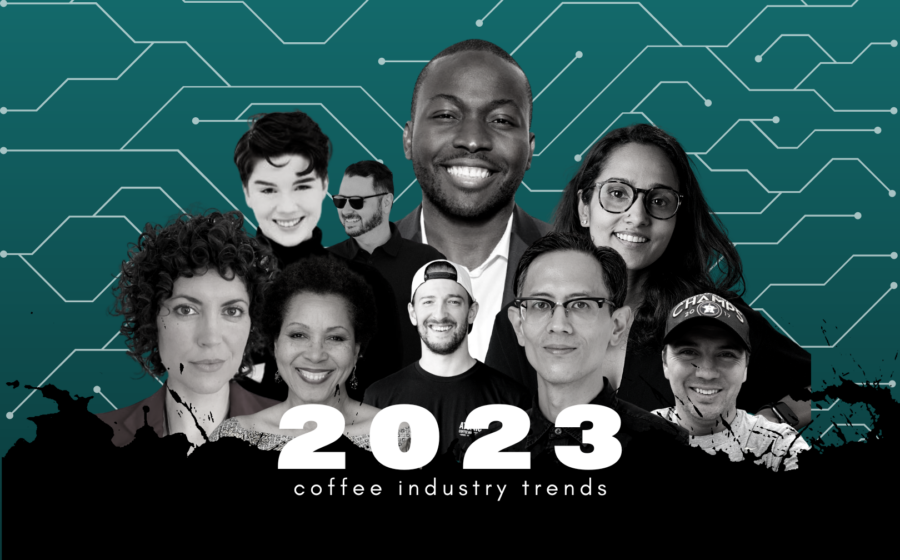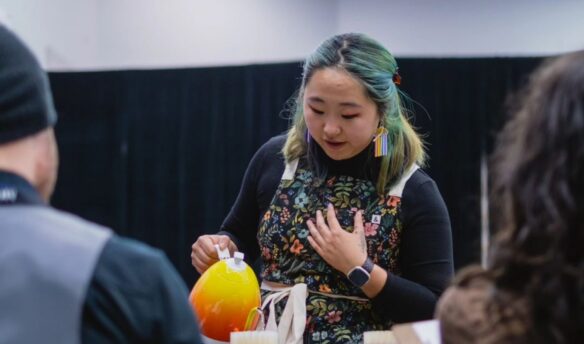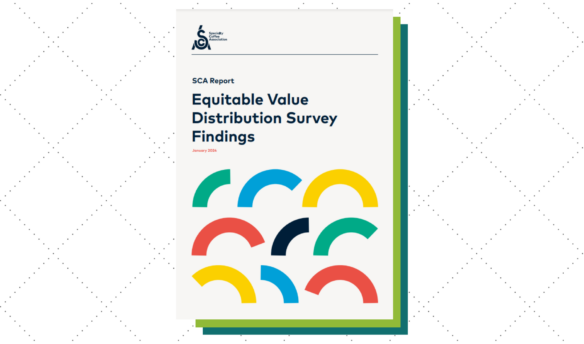In an industry like coffee, there’s no shortage of new innovations and emerging trends: new brewers, creative roasting styles, marketing macro trends, frozen coffee, instant coffee, beanless coffee … The list goes on, and the excitement never ends.
Now that we’re comfortably in 2023, we thought we’d examine some of the trends we’ve seen over the last few months—and a few we’re watching for in the coming year. We spoke to experts from around the industry about what to watch in 2023. From changing consumer expectations to wellness-oriented coffee menus and automation in roasting, these emerging trends represent meaningful shifts in how the coffee industry operates.
Business leaders: take note.
📩 Get the latest coffee trends in your inbox weekly—subscribe here.
Personalization Is Coming For Coffee Roasters
Miranda Caldwell, Coffee Business Strategist at The Coffee MBA
“Customization and ‘fresh for you’ coffee will become increasingly important for roasters to tackle. With small-batch roasters that are easy for operators to use (think Nestlé’s Roastelier) and even some home-roasting technology coming down the pike, coffee drinkers will become more and more aware of options to have coffee made just for them.
Through quizzes and thoughtful operations, roasters can respond and learn the profiles of their consumers to begin delivering something that feels tailor-made. I believe consumers will want to participate more and more in the process of product creation, and it’s up to roasters to innovate around that experience.”
Coffee-Producing Countries Will Drive More Coffee Innovation
Namisha Parthasarathy, Co-Founder at Aramse Coffee
“Coffee companies ought to be paying attention to evolving consumption trends in producing countries. In India, though coffee consumption hasn’t seen the exponential growth anticipated just yet, green shoots are starting to emerge with specialty roasters cropping up across the country and capital being deployed to coffee startups (Blue Tokai raising $30 million in Series B is viewed as a harbinger of the industry’s prospects). Of particular note is a surge in RTD coffee beverage offerings. Consumers in these newer markets look for novelty, diversity, and compelling branding/storytelling, and companies will have to adapt their offerings accordingly.
Looking globally, espresso developments are being taken up a notch. Since the launch of the Unifilter by Weber Workshops, we’re seeing more companies like Wafo and Sworkdesigns innovate at the basket level, signaling that the next wave of baskets is upon us. Due to customer demand for home espresso, we’re also seeing affordable alternatives to the Decent Espresso machine. These machines are hi-tech and use multiple sensors and probes hooked up to a computer to help you make better espresso.”
Tea Service Is Becoming A Sophisticated Experience
Casey Chartier-Vignapiano, Marketing Manager at Spirit Tea
“On the tea side of things, we are noticing an inspiring uptick in presentation and service. This goes many ways, from the visual presentation of brewed tea to the theatrics of a signature tea beverage. More accounts approach us for tea service and presentation consulting; they want to make it special, personal, and technically correct.
What this looks like: asks for a tailored and exciting menu, more tea palate training requests, more emails in my inbox asking for specific order info, printed media cards, and help with tea content on their social channels.
Patrons are so thankful to be able to stay a while at the cafe, and cafe workers are making the most of it. Tea menus are becoming more daring: high-mountain oolongs and non-traditional-to-Western audiences herbals like Osmanthus.
I love seeing tea move from being a minor menu accessory to holding its own as a tasting experience.”
Regulations Will Advance Coffee Sustainability in One Way or Another
Jorge Cuevas, Chief Coffee Officer at Sustainable Harvest
“The coffee industry is definitely not in a position to backtrack or even slow down in terms of sustainability. Whether it means baseline verification or interest in particular projects, the topic is squarely at the forefront, driven by reputational risks and a dose of regulation.
With deforestation regulation looming in Europe, coffee companies all over will have to adapt quickly. For those not based in Europe, keep in mind that regulatory protocols established in one place can be quickly replicable elsewhere.
In summary, a clear sense of purpose about sustainability will emerge as a major priority in the coffee industry. Elements like traceability and transparent supply chains will naturally underpin any efforts on this front.”
Automation Will Save Home Brewing—Or Over-Complicate It
Morgan Eckroth, Coffee Creator at Morgan Drinks Coffee & Marketing Specialist at Onyx Coffee Lab
“I think one thing I’ve been very conscious of in the last few years is the increased prevalence of semi to fully automatic coffee solutions explicitly geared towards specialty coffee consumers. While quite a bit of interesting innovation and products have emerged, I’m cautious about how much longevity they’ll have.
One part of home coffee consumption that’s hard to replicate is the physical ritual of coffee brewing. The actions of weighing out coffee, grinding it, hand brewing … it all culminates in a tactile and psychological experience that resonates with folks. It feels like we’re rapidly accelerating towards companies automating at-home coffee to the point where it’s over-engineered.
I could certainly be wrong, but I think we’ll really see in the next year or so which products have longevity and which can’t find their target market.”
Lions Mane, Chaga, and Spirulina—Oh My
Andrew Heppner, Founder at Populace Coffee
“The cafe menu has been evolving since I placed my first portafilter up to a grinder and into the group head of the espresso machine. Baristas have become more efficient and more consistent with the proliferation of tools dedicated to the craft of precision.
Now that we’ve dialed in the coffee part of the experience, we have seen a growing number of customers wanting more from their beverage than just the caffeine and utility that a black coffee or oat milk cappuccino provides.
Matcha. Lions Mane. Chaga. Beet Root. Spirulina. These powders are charging onto menus across the country and gaining daily market share at the POS system, mostly because of their health benefits and the rise of adventurous beverage consumption. They are being served hot or iced and alongside organic oat milk and pure maple syrups to add a touch of sweetness.
We’ve seen a lot of demand for these health-focused drinks and recently rolled out a Wellness Menu at Populace coffee shops in January.
I don’t think these drinks will replace the black coffee soon, but they are making their case for being staple menu items into the future, and I’m here for it!”
Mission Statements Are Not Enough For Younger Customers
Jim Ngokwey, Managing Partner at Mighty Peace Coffee
“Each generation is more socially conscious and active than the previous one. With Gen Z coming of age, their values in terms of climate protection and labor movements will provide opportunities to brands committed to paying fair wages wherever they work and protecting the environment. Mission statements will no longer be enough—actions and results will be expected.”
It’s Going to Be A Hot Year for Cold Coffee
Spencer Mahoney, VP of Operations at Atomic Coffee Roasters
“I think cold coffee is going to continue evolving in 2023. Whether it’s different blends and single-origin cold brew options, or different processes of brewing like Elemental’s Snapchill, consumers are showing that they’re interested in going deeper with ready-to-drink cold coffee options. Curiosity is growing when it comes to coffee origin, processing method, brew method, and taste notes in cold coffee, just as we’re accustomed to consumers being interested in exploring the subtleties of those things in hot coffee.
At Atomic, we’ve started thinking about our cold brew program the same way we think about rotating roasts. We have our “house blend” options and then plan out the calendar with limited-release offerings to accompany our coffee menu.
We just debuted our third limited-release offering in the last six months, and the response and sales have continued to grow. Our customers get the chance to taste the differences in flavor and aroma that come with using a variety of coffees in cold brew, just as they would brewing two coffees on a pour-over at home.”
Asian and Western Consumer Demands Are Diverging
Will Frith, Founder, Product Director at Building Coffee
“I think that Asian and Western markets are going to experience somewhat opposite things regarding demand for different types of coffee flavor profiles and coffee drink experiences.
In Asia, top-shelf specialty will continue to grow as more populations shift towards majority middle-class economies. Entrants into the middle class will seek novelty and luxury experiences in all segments, with coffee being just a small part of that discovery. Consumers will look for smaller companies, and there will be plenty of up-and-coming micro-roasters for them to find.
In the West, mainstream and mainstream-adjacent consumers will begin to fatigue on specialty coffee’s typical messaging, and some will rebel against what they perceive as frivolous or “too fancy.” There will be some bottom-line adjustments, too, as rising costs will cause people to prioritize certain types of spending. Specialty consumption may continue to grow, but nowhere near the explosive growth of the past decade. Coffee companies will need to be mindful of their messaging, especially around lifestyle and values. I believe we’ll see more reputable specialty darlings release good-value/quality blends to respond to this shift.
Robusta will continue its march into the West. The quality and availability of traceable canephoras will capture the imaginations of forward-thinking coffee companies, curious coffee drinkers, and folks who had historically stuck with “low brow” consumption. This will reach what I think is a good sized market of those “left behind” by the light, bright, and fruity coffee wave of the past decade-plus.”
Automation in Roasting and Espresso Will Force Professionals to Rethink Responsibilities and Craft
Andy Newbom, Instigator at Torque Coffees
“Automation will increasingly lead to even more abdication. From making espresso to roasting coffee, the inexorable rise of ‘no experience, training, interest or knowledge needed!’ will continue to dominate. Superautomatic espresso machines will become dominant in low-end to high-end coffee bars. Baristas will increasingly be experienced concierges for customers who care and credit card machine holders who don’t care as much.
Every coffee location will ‘roast,’ and at some point, the roaster and the espresso machine will combine. Using rapid roast conveyor belt-type systems, a customer’s coffee will be continuously roasted per drink and then ground and extracted into a cup. Flash roasting 15 grams of coffee fresh per drink and then extracting that immediately sounds crazy, but so once did the Everysys superautomatic machine and robot ‘baristas.'”
Black and Brown Coffee Entrepreneurs Are Leading the Way Toward Inclusivity and Equity
Phyllis Johnson, President and Co-Founder of BD Imports and The Coffee Coalition for Racial Equity
“The relentless passion and hard work of Black and Brown entrepreneurs is driving consumption and engagement within these communities, and finally, after several years, the data is now reflecting what has seemed to be a trickling effect on how the Black coffee community responded to the call to action building businesses and opportunities within the communities with ownership. It’s now simply showing up in the numbers. Congratulations!
However, it’s hard for me to say that Blackness is an emerging trend in coffee in 2023 when there are so many past and present contributions, although unaccounted for and without acknowledgment.
Whether it’s uplifting and creating opportunities for local communities like the ones we grew up in or creating opportunities back in the home country, which also happens to be a coffee-producing country, these are all part of the business plan of Black and Brown coffee entrepreneurs. We are putting in the work while understanding the desire for change as an immediate and personal need, not to be lost inside bureaucratic systems that offer minimal to little results.
If I might add a bit of advice to my fellow Black and Brown entrepreneurs: I strongly believe that diverse coffee entrepreneurs of today must take a page from the European immigrants of yesterday’s playbook and view alignments and partnerships within the community as necessary to success, strengthening the entire community and growing together. While understanding exclusion isn’t the plan, we need everyone at the table, and we can’t function without everyone at the table, but strategic actions for engagement are necessary. It’s not enough for one business to take up space as a diverse supplier; it must develop a plan to bring others along.
The work must be multiplied and impactful throughout the community.
See yourself as the center for opportunities of building community, not just the recipient of opportunities. Let’s keep expanding!”
The Line Between Professional and Home Gear is Blurring
Garrett Oden, Owner / Publisher at Fresh Cup Magazine
“The home coffee experience has become far more popular and sophisticated in the last couple of years, and it will evolve further in 2023. Coffee brands of all kinds—including pro-focused companies—should intentionally create products and opportunities for customers to engage with their brands at home.
You can see just how much potential there is in home-driven experiences when the most prestigious professional equipment makers have created gear for home brewers, like the La Marzocco Linea Micra and the Mahlkönig X54 Allround home grinder.
On the coffee bean side of things, things like creative advent calendars and tasting competitions show that many customers don’t just want to buy beans—they want coffee experiences they can share with their friends and family at home.”















